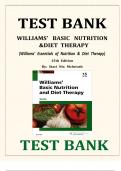Exam (elaborations)
Test Bank for Williams Basic Nutrition and Diet Therapy 16th Edition by Nix William:TEST BANK FOR WILLIAMS’ BASIC NUTRITION AND DIET THERAPY 16TH EDITION: Updated A Plus Solution: (Chapter 1_23)
Test Bank for Williams Basic Nutrition and Diet Therapy 16th Edition by Nix William:TEST BANK FOR WILLIAMS’ BASIC NUTRITION AND DIET THERAPY 16TH EDITION: Updated A Plus Solution: (Chapter 1_23)
[Show more]



